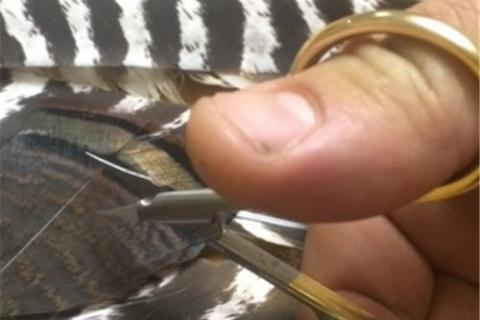
With many different types of scissors available to the avid fly tier, trying to pick out a quality pair is not as easy as it might sound. Different sizes, styles and lengths can all effect how scissors perform. Understanding the basics will help you choose the perfect pair.
Choose the Best Blades
Tying scissors can range anywhere from 3 to 8 inches in length. Every fly tier has their own preference, so experiment with a few until you find what is right for you. Blades should be long enough to make trimming easy, but short enough to allow for precise cuts. Personally I prefer a four inch pair that is just a bit longer than the shortest models.
 |
| No matter which pattern you are tying, a good pair of scissors is essential. Be sure to try out different styles, sizes, and blades. |
The pair I use has straight blades. This allows me to make precise cuts by using my off hand to steady what I am doing. Curved bladed scissors are billed as having special applications in fly tying, but over the years I have not found anything that I cannot do with my straight bladed scissors.
Just as there are multiple lengths and shapes to scissors, there are also different types of cutting edges. Different edges are better for different materials. Serrated blades work best for dense, rough materials, and slippery synthetics. Straight blades are better for cutting fine, smooth materials and fragile naturals.
Don’t Lighten Up
The scissors that you choose should be weighted appropriately and balanced from the tip to the loops. When shopping, pick up and try the scissors in your hand. The pair you choose should not be extremely light, but should also not be heavy enough to cause fatigue in your fingers. Keep in mind that better quality steel scissors will weigh much more than cheaper aluminum pairs. A balanced, weighted, pair of scissors will actually help to steady the precise scissor tips when performing delicate cuts. In addition, a heavier pair of quality scissors will aid the tier in cutting dense stiff materials, like deer hair or raffia, when lighter models will bind up.
Find the Right Fit & Function
Tying scissors can have three different styles of eyes: round, oval or open loops. Whatever style you choose, make sure that when you seat the scissors on your fingers there is enough room for them to slide back and forth freely. Most tiers like to “palm” their scissors as they tie, but if the pair you choose fits too tight, you will not have the freedom you need to tie delicate flies.
Look for a pair of scissors that opens and closes easily but stays shut when you place the jaws together. Look along the closed blades and make sure they meet evenly along the entire surface of the blade. Scissors that do this should cut smoothly through the entire stroke. Also, having a fine tip to the scissors you select will allow you to get into hard to reach spots and make precision cuts.
When purchasing a new pair of scissors take the time to try different styles, lengths and blades. Find the pair that fit your hand and needs the best. The right pair of scissors will last many years, be comfortable to use, and give precision cuts every time.
- 7556 views

